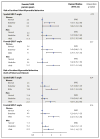Electrocardiographic QRS-T angle and the risk of incident silent myocardial infarction in the Atherosclerosis Risk in Communities study
- PMID: 28515002
- PMCID: PMC5612427
- DOI: 10.1016/j.jelectrocard.2017.05.001
Electrocardiographic QRS-T angle and the risk of incident silent myocardial infarction in the Atherosclerosis Risk in Communities study
Abstract
Background: Silent myocardial infarction (SMI) accounts for about half of the total number of MIs, and is associated with poor prognosis as is clinically documented MI (CMI). The electrocardiographic (ECG) spatial QRS/T angle has been a strong predictor of cardiovascular outcomes. Whether spatial QRS/T angle also is predictive of SMI, and the easy-to-obtain frontal QRS/T angle will show similar association are currently unknown.
Methods: We examined the association between the spatial and frontal QRS/T angles, separately, with incident SMI among 9498 participants (mean age 54years, 57% women, and 20% African-American), who were free of cardiovascular disease at baseline (visit 1, 1987-1989) from the Atherosclerosis Risk in Communities (ARIC) study. Incident SMI was defined as MI occurring after the baseline until visit 4 (1996-1998) without CMI. The frontal plane QRS/T angle was defined as the absolute difference between QRS axis and T axis. Values greater than the sex-specific 95th percentiles of the QRS/T angles were considered wide (abnormal).
Results: A total of 317 (3.3%) incident SMIs occurred during a 9-year median follow-up. In a model adjusted for demographics, cardiovascular risk factors and potential confounders, both abnormal frontal (HR 2.28, 95% CI 1.58-3.29) and spatial (HR 2.10, 95% CI 1.44-3.06) QRS/T angles were associated with an over 2-fold increased risk of incident SMI. Similar patterns of associations were observed when the results were stratified by sex.
Conclusions: Both frontal and spatial QRS/T angles are predicative of SMI suggesting a potential use for these markers in identifying individuals at risk.
Keywords: Electrocardiography; QRS/T angle; Silent myocardial infarction.
Copyright © 2017 Elsevier Inc. All rights reserved.
Conflict of interest statement
The authors have no conflicts of interests to disclose.
Figures

Comment in
-
Electrocardiographic risk stratification of asymptomatic population without cardiovascular disease: Should we add the QRS-T angle?J Electrocardiol. 2017 Sep-Oct;50(5):543-544. doi: 10.1016/j.jelectrocard.2017.06.009. Epub 2017 Jun 8. J Electrocardiol. 2017. PMID: 28623014 No abstract available.
Similar articles
-
Silent Myocardial Infarction and Long-Term Risk of Heart Failure: The ARIC Study.J Am Coll Cardiol. 2018 Jan 2;71(1):1-8. doi: 10.1016/j.jacc.2017.10.071. J Am Coll Cardiol. 2018. PMID: 29301615 Free PMC article.
-
Comparison of the prognostic significance of the electrocardiographic QRS/T angles in predicting incident coronary heart disease and total mortality (from the atherosclerosis risk in communities study).Am J Cardiol. 2007 Sep 1;100(5):844-9. doi: 10.1016/j.amjcard.2007.03.104. Epub 2007 Jun 18. Am J Cardiol. 2007. PMID: 17719331 Free PMC article.
-
Usefulness of electrocardiographic QRS/T angles with versus without bundle branch blocks to predict heart failure (from the Atherosclerosis Risk in Communities Study).Am J Cardiol. 2014 Aug 1;114(3):412-8. doi: 10.1016/j.amjcard.2014.05.011. Epub 2014 May 16. Am J Cardiol. 2014. PMID: 24929625 Free PMC article.
-
Silent myocardial infarction and risk of heart failure: Current evidence and gaps in knowledge.Trends Cardiovasc Med. 2019 May;29(4):239-244. doi: 10.1016/j.tcm.2018.09.004. Epub 2018 Sep 8. Trends Cardiovasc Med. 2019. PMID: 30224236 Review.
-
T wave axis deviation and QRS-T angle - Controversial indicators of incident coronary heart events.J Electrocardiol. 2017 Jul-Aug;50(4):466-475. doi: 10.1016/j.jelectrocard.2017.02.008. Epub 2017 Feb 20. J Electrocardiol. 2017. PMID: 28262257 Review.
Cited by
-
Automatic identification of a stable QRST complex for non-invasive evaluation of human cardiac electrophysiology.PLoS One. 2020 Sep 17;15(9):e0239074. doi: 10.1371/journal.pone.0239074. eCollection 2020. PLoS One. 2020. PMID: 32941513 Free PMC article.
-
Elective lung resection increases spatial QRS-T angle and QTc interval.Cardiol J. 2020;27(6):705-714. doi: 10.5603/CJ.a2018.0159. Epub 2018 Dec 21. Cardiol J. 2020. PMID: 30575004 Free PMC article.
-
Relationship between frontal QRS-T duration and the severity of coronary artery disease in who were non-diabetic and had stable angina pectoris.Anatol J Cardiol. 2021 Aug;25(8):572-578. doi: 10.5152/AnatolJCardiol.2021.33232. Anatol J Cardiol. 2021. PMID: 34369885 Free PMC article.
-
Improved evaluation of left ventricular hypertrophy using the spatial QRS-T angle by electrocardiography.Sci Rep. 2022 Sep 6;12(1):15106. doi: 10.1038/s41598-022-16712-3. Sci Rep. 2022. PMID: 36068245 Free PMC article.
-
The Effect of Low-Flow and Normal-Flow Desflurane Anesthesia on the Frontal QRS-T Angle in Patients Undergoing Rhinoplasty Operation: A Randomized Prospective Study.Cureus. 2022 Sep 8;14(9):e28920. doi: 10.7759/cureus.28920. eCollection 2022 Sep. Cureus. 2022. PMID: 36225439 Free PMC article.
References
-
- Thygesen K, Alpert JS, White HD on behalf of the Joint ESC/ACCF/AHA/WHF Task Force for the Redefinition of Myocardial Infarction. Universal definition of myocardial infarction. Circulation. 2007;116:2634–53. - PubMed
-
- Thygesen K, Alpert JS, Jaffe AS, et al. The writing group on behalf of the Joint ESC/ACCF/AHA/WHF Task Force for the Universal Definition of Myocardial Infarction. Third universal definition of myocardial infarction. Circulation. 2012;126:2020–35. - PubMed
-
- Mozaffarian D, Benjamin EJ, Go AS, et al. American Heart Association Statistics Committee; Stroke Statistics Subcommittee. Heart disease and stroke statistics—2016 update. A report from the American Heart Association. Circulation. 2016;133:e255–69.
-
- Sheifer SE, Gersh BJ, Yanez ND, III, et al. Prevalence, predisposing factors, and prognosis of clinically unrecognized myocardial infarction in the elderly. J Am Coll Cardiol. 2000;35:119–26. - PubMed
-
- Kannel WB, Abbott RD. Incidence and prognosis of unrecognized myocardial infarction. An update on the Framingham study. Med. 1984;311:1144–7. - PubMed
Publication types
MeSH terms
Grants and funding
- HHSN268201100012C/HL/NHLBI NIH HHS/United States
- HHSN268201100009I/HL/NHLBI NIH HHS/United States
- HHSN268201100010C/HL/NHLBI NIH HHS/United States
- HHSN268201100008C/HL/NHLBI NIH HHS/United States
- HHSN268201100005G/HL/NHLBI NIH HHS/United States
- HHSN268201100008I/HL/NHLBI NIH HHS/United States
- HHSN268201100007C/HL/NHLBI NIH HHS/United States
- HHSN268201100011I/HL/NHLBI NIH HHS/United States
- HHSN268201100011C/HL/NHLBI NIH HHS/United States
- HHSN268201100006C/HL/NHLBI NIH HHS/United States
- R01 HL118277/HL/NHLBI NIH HHS/United States
- HHSN268201100005I/HL/NHLBI NIH HHS/United States
- HHSN268201100009C/HL/NHLBI NIH HHS/United States
- HHSN268201100005C/HL/NHLBI NIH HHS/United States
- HHSN268201100007I/HL/NHLBI NIH HHS/United States
LinkOut - more resources
Full Text Sources
Other Literature Sources
Medical
Molecular Biology Databases

